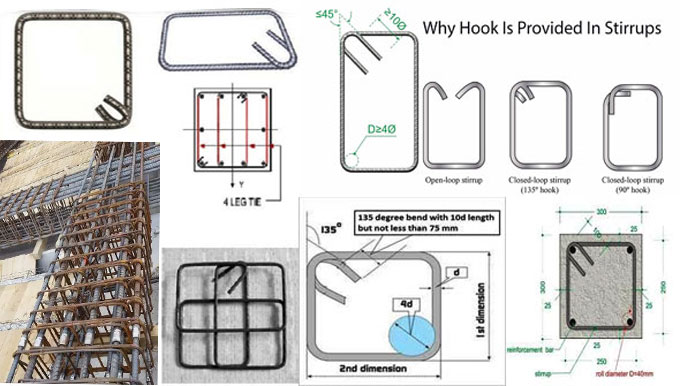
The Importance of Stirrups in Concrete Work: Enhancing Strength and Stability
Ensuring a structure's strength, stability, and lifespan is crucial in concrete construction. Stirrups are one of the key components that go into creating these traits among other factors. To create a reinforced concrete framework, stirrups like reinforcing bars bent into a U or rectangular shape are put around vertical bars.
Importance of Stirrups in Construction
Construction workers may build sturdy, long-lasting structures that satisfy the greatest standards of safety and reliability by recognizing the significance of stirrups in concrete work. Stirrups are essential for strengthening, stabilizing, and extending the life of concrete structures.
Construction experts may guarantee the best performance and longevity of their reinforced concrete projects by understanding the various types of stirrups, improvements in their design and materials, and the significance of quality control and inspection.
Learn the importance of stirrups in the construction industry, how they reinforce structures, and how they increase a structure's strength and stability. Discover the importance of stirrups in building and how they improve the sturdiness and longevity of concrete constructions.
Understanding the Role of Stirrups
Stirrups are crucial parts of reinforced concrete constructions, including foundational beams, columns, and columns. Their main job is to withstand shear stresses and stop the diagonal cracking that might develop in concrete components while they are under load. Stirrups effectively limit the concrete by enclosing the longitudinal bars, offering support against lateral motions and guaranteeing the structural integrity of the elements.
Enhancing Strength and Durability
Stirrups greatly increase the longevity and strength of concrete constructions. Concrete receives both compressive and tensile forces when it is subjected to loads, such as the weight of the building or outside pressures. Concrete is strong in tension yet very good at resisting compression pressures. Stirrups work to overcome this flaw by constraining the concrete, preventing it from splitting, and ensuring that the tensile forces are passed to the longitudinal bars, which are better equipped to handle tension.
Furthermore, the presence of stirrups makes concrete components more ductile. The ability of a substance to deform without breaking is referred to as ductility. Stirrups increase the ductility of the concrete by enclosing it, enabling it to absorb and release energy during seismic events or other stresses more effectively, increasing the overall robustness of the building.
Placement and Design Considerations
Stirrup placement and design are essential for ensuring their effectiveness. The size and shape of the stirrups, which should be positioned at regular intervals along the longitudinal bars, should be determined by the unique structural requirements and projected loads for the concrete member. Stirrup sizes and spacing vary depending on the type of structure, the magnitude of the loads, and the regional design standards or regulations.
Additionally, stirrups need to be bent and anchored with care. To keep their position and avoid movement during the pouring of concrete and subsequent stresses, stirrups must be sufficiently bent and fixed. The performance and efficacy of the stirrups can be hampered by improper bending or insufficient anchoring, which may eventually cause structural problems.
Types of Stirrups and Their Applications
Stirrups occur in a variety of forms and dimensions, each one suited for certain uses and structural specifications. Stirrups come in a variety of shapes, including helical, circular, and rectangular ones. While circular stirrups are frequently used in circular or curved buildings, rectangular stirrups are frequently used in beams and columns.
Spiral ties, commonly referred to as helical stirrups, are used to strengthen cylindrical structures like columns and piers. Engineers and construction professionals can choose the best reinforcement for their unique project needs by being aware of the many stirrup types and their applications.
Advancements in Stirrup Design and Materials
Construction technology has advanced, and stirrup design and materials have followed suit. Traditionally, mild steel was used to make stirrups, but today, high-strength materials like steel alloys and fiber reinforced polymers (FRP) are being used more frequently. These materials boost the structure's strength, durability, and resistance to corrosion, which helps it last longer and function better overall.
Furthermore, more accurate and optimized stirrup designs are possible thanks to cutting edge computer-aided design (CAD) software and simulation tools, which take a variety of structural elements and load situations into account. Construction workers may make informed decisions and incorporate creative solutions into their projects by keeping up with the newest developments in stirrup design and materials.
Quality Control and Inspection of Stirrups
The efficiency of reinforced concrete constructions depends heavily on the quality and proper installation of stirrups. Before installation, the stirrups are inspected for size, shape, and material, as well as for compliance with the design specifications and any relevant rules or standards.
Regular checks should be done to ensure that stirrups are anchored, spaced, and placed correctly during construction. To avoid jeopardizing the structural integrity of the concrete members, any deviations or faults should be immediately corrected. The dependability and safety of the reinforced concrete construction must be ensured by using qualified inspectors and following quality control procedures.
To get more details, watch the following video tutorial.
Video Source: Civil Engineers
Wrapping it Up
Stirrups are essential for strengthening, stabilizing, and preserving the structural integrity of concrete buildings. Stirrups prevent cracking and improve the structural integrity of elements subjected to varying loads by containing the concrete and resisting shear pressures.
The strength, ductility, and resilience of concrete elements are considerably increased by their presence. For stirrups to operate at their best, positioning, sizing, and anchoring are crucial factors to take into account.


